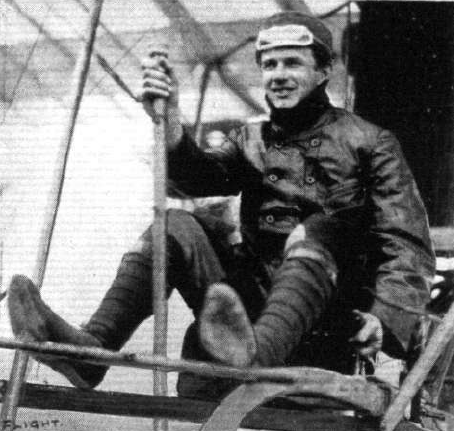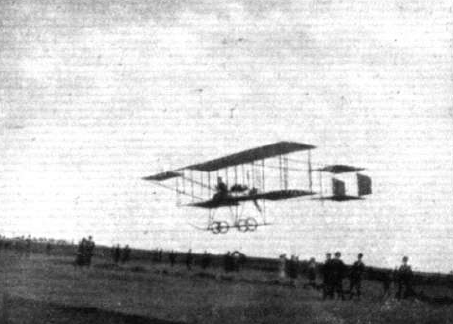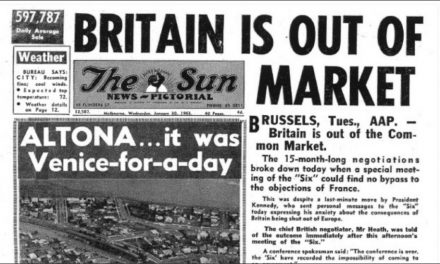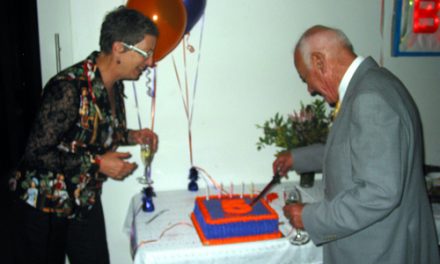Hobsons Bay and the Altona Laverton Historical Society celebrated the 100th year of aviation history in Altona this year.
Altona has been claimed as the birthplace of Australian aviation (Ref 1). Apart from hosting many successful public demonstration flights, Australia’s first cross-country flight, first passenger and first chartered flight all took off from Altona.
The successful powered flight of the Wright brothers on 17 Dec 1903 at Kitty Hawk, North Carolina, United States marked a new era for mankind. Within a few years, aviators were travelling around the world, showing the general public the wonders of their new flying machines. However, most arrived in Australia as showmen, arriving and leaving a place within a day or so and therefore did not leave behind lasting impact. The famous escapologist Harry Houdini was one such visitor who made Australia’s first successful powered flight in his Voisin biplane on 18 Mar 1910 at Diggers Rest. It was left to those who made Altona the base of their early flights to make a dramatic and significant impression on Victorian history and society.
Gaston Cugnet – Blériot Flights
In November 1910, Gaston Cugnet, a French aviator, brought his Blériot Monoplane to Australia and made Altona his base. With a single set of wings, a long slender body and a tail, the 28-feet long, 550-pound Blériot resembled a mammoth dragonfly. It was powered by a 25 horse-power Anzani engine and had 2 running wheels and a third wheel out towards the back.
Video of Blériot Monoplane by audlm
At this time, Altona’s population was not more than 50 people living in 15 houses spread between Seaholme and Rose Street. The wide open spaces made Altona a most suitable location for experimental flights.
On 15 Nov 1910, Cugnet made his first successful flight from Altona Estate (probably from a flat grassed area between the rail line and Queen Street and west of Pier Street), reaching a height of almost 200 feet and travelling a distance of about 6 miles in 7 minutes. However, on landing, he bumped into a cow with more damage to the plane than the cow.
The Most Thrilling Sight of Modern Times
Cugnet decided to hold a public flight demonstration on 26 Nov 1910 at Altona. He advertised the event as the “Most Thrilling Sight of Modern Times” which attracted about 3ooo visitors. Trains ran from Flinders Street to Williamstown Racecourse Station (near the present Altona Coastal Park) and a steamer service from Port Melbourne. The return train fare including admission was 45 cents and by steamer 35 cents. Cabs charged 20 cents to drive visitors from the train station to the aerodrome, which was 2 miles away. A wide reserved space between Altona House and a row of trees, was named the ViceRegal Reserve. Admission to this was charged at one guinea per person, limited to 100 persons. But as there was no one to prevent it, the crowd climbed through the barriers.
The event was attended by Federal and State MPs and the then Acting Prime Minister Billy Hughes (Australia 7th PM) who christened the monoplane “The Australia” . He said that France had led the way in aviation, as it had in motoring. Cugnet and other Frenchmen beamed. Mr. Hughes then smashed a bottle of champagne, poured over himself and splashed the monoplane with a few drops. The crowd cheered enthusiastically.
At 5.40 p.m., the monoplane was wheeled out to the paddock. Cugnet appeared amidst the cheers and climbed onto the plane. There were cries of “He’s off?” But he was not. He sat quietly in his seat, while the members of the committee stood around the machine discussing the wind. It had been slight all afternoon but was now growing into upsetting gusts. “Let her go” suggested the crowd. It was expected that the wind would lull in the early evening so both Cugnet and the committee were prepared to wait. The crowd became impatient and began to talk about getting their money back and missing their train or steamer.
The committee decided to set the engine going to show the machine at work. The crowd misunderstood that the plane was about to take off. When it was realized that no flight was intended, the anger broke forth afresh. For the safety of the machine, the committee formed a cordon while the police on horseback drove the people back.
At 7 p.m., when it was clear that the wind would not moderate, the machine was wheeled back amidst jeering to its canvas hangar. Cugnet said in a letter to the Melbourne press: “It was almost regrettable that the wind was so strong that any attempt to fly would have been to risk serious injury to the only machine – it is important to note we have in Australia. My Blériot machine carried only a 25 h.p. Anzini engine, which is not strong enough to fight against squally winds such as prevailed at Altona on Saturday. Had I gone on Saturday, the motor, which must be slowed down when landing, would have left me at the mercy of the wind, and a smash would have been inevitable. I am not a showman. I have come to Australia with three confreres to establish a school of aviation. It may be some consolation to Saturday’s visitors to know that at exhibition flights in Europe, visitors frequently wait right through a day in the expectation of a flight, which even then is not always certain.”
The disappointment of the crowd was summed up in a report in the Advertiser: “Well if this wind can stop a flying machine, nobody but a Frenchman would get excited about such an invention”.
J. J. Hammond – Bristol Boxkite Flights
Word must have spread through aviation circles that Altona was a most suitable location for experimental flights because just 3 months later, another aviator Joseph J. Hammond arrived who was destined to make history.
He was sent on a mission by his employer, the British and Colonial Aeroplane Company (Bristol) and arrived in Perth on 13 Dec 1910 with 2 Bristol Boxkites each fitted with a 50 horsepower Gnome engine. He made a successful flight over Perth on 6 Jan 1911, after several postponements due to windy weather. Later flight failures also due to the wind, led to hostile demonstrations. The mission moved to Melbourne in January 1911, hoping to interest the Commonwealth Government in purchasing planes for military reconnaissance. If successful, the company would establish a factory in Melbourne to build the planes.
Video of Bristol Boxkite by audlm
The party selected the site at the rear of Altona House as their flight headquarters. At 6.42 a.m. on 18 Feb 1911, Hammond undertook his first Victorian flight before a small crowd which included Major H. C. Foot of the Royal Australian Engineers, sent by the Australian Chief of the General Staff, Brigadier-General Gordon. Hammond flew over Williamstown and then to the joy of train commuters, followed the Geelong Express Train. Turning north, he flew over Sunshine before returning to Altona where he glided down and made a perfect landing only 20 yards from the spectators. Hammond was in the air for 31 minutes up to a height of 3000 feet and had travelled over 20 miles.
Major Foot was very impressed and advised that the Minister of Defence would come and watch a flight. He also suggested purchasing 4 planes and employing 8 trained aviators and 10 mechanics. It was not until 2 years later in 1913, after the visit of the Defence Minister to England, that the Commonwealth Government ordered 2 Bristol Aeroplanes to start the first flying school at Point Cook.
First Cross Country Flight
Hammond announced that he would attempt a flight from Altona to Geelong on 20 Feb 1911, taking his wife along as passenger. At 5.59 a.m., he took off for a test flight and his wife waited on the ground, ready to accompany him. Hammond flew to 4000 feet and finding conditions good for flying, decided to fly straight off to Geelong leaving his wife behind at Altona. She went to Geelong by car.

Photo of J.J. Hammond from Flight Magazine scanned by Flightglobal Archive
Hammond followed the railway line to Geelong and landed on the Geelong Racecourse, taking 55 minutes to cover 42 miles. On the following day at 6.15 a.m., he headed back for Altona. Soaring over the City of Geelong at great height, he crossed Corio Bay in a direct line to Altona where he landed 50 minutes later, after covering 39 miles. He changed the engine overnight and next morning at 7 a.m., he flew to Sunshine and back to Altona over a distance of 25 miles.
First Passenger
Another “first” accolade was achieved when Hammond flew around Altona for 12.4 miles with his wife as a passenger on 23 Feb 1911.

Hammond taking his wife as the first passenger, source: Flightglobal Archive
One of his mechanics, Frank Coles, was his passenger on the next short flight. They ventured further, flying over Williamstown, Port Melbourne, St. Kilda, Albert Park, Government House, the Exhibition Buildings, Bourke Street and Spencer Street for 28 minutes.
First Australian Passenger
This achievement had generated widespread publicity and it was inevitable that other interested parties would seek to experience the thrill of being taken aloft in a powered machine.
On 2 Mar 1911, two new records were established. A Melbourne businessman, M. H. Baillieu, paid to be taken for a flight. This was the first paid charter flight and the first carrying an Australian citizen as a passenger. Hammond took another businessman, W.J. Knox, as a passenger on a flight later in the morning.
Hammond Public Flying Demonstrations
Hammond held public demonstrations on March 3 and 4. On 3 Mar 1911, a special train carrying 60 passengers left Central Station at 5.50 a.m. and another 60 came from Port Melbourne by the steamer Williamstown. The steamer passengers saw the plane rise above a clump of pine trees, fly south, then turn back at low altitude and land as they arrived at the flying field. By this time, there were 400 spectators. Wasting no time, Hammond restarted the engine and again took to the air. The machine rose but began circling at a low altitude and was seen to sink into a field near the mine. The plane chugged again, went over a hedge and half flying and half running along the ground came to a standstill. An examination showed that the engine had a broken inlet valve. So as not to disappoint the crowd, the engine was removed and replaced with another which was being cleaned. This engine “sulked” but after being lubricated with oil, Hammond was able to set off on a fourth flight and for 6 minutes engaged in the most intricate manoeuvres, never above 200 feet. An even larger crowd, estimated at more than 500, came to watch the demonstrations the next morning.
Both Hammond and his manager, Mr. Smith, were disgusted by the many wealthy people present who refused to pay the small charge asked. The poorer people paid and expressed their satisfaction with the display.
On 8 Mar 1911, a staff member from “The Age” was taken aloft and his enthusiastic impressions were recorded in a whole column of the paper. After this flight, the party moved to a 640 acres paddock near the Albion railway siding. Public demonstrations followed as well as numerous other flights before Hammond moved on to New South Wales where Hammond first flew on 2 May 1911.
Commemorative Ceremony
A small boy named Harry Rigby cycled all the way from the other side of Melbourne to visit the flights in 1911. He returned as a well known artist in September 1969 and presented the Altona Historical Society with a painting of the historic flights in 1911 as he remembered it. The gift was made during the ceremony to unveil a historic plaque on a shop front in Pier Street by the then Air Minister, Sir Donald Anderson. The plaque erected by the Altona Historical Society commemorated the flights and Altona’s unique place in aviation history.
It is a well known fact that it was largely as a result of the publicity surrounding these pioneer flights from Altona that the Government became intensely interested in both the establishment of an air base and its location in the same general area. It was from a combination of these factors and the deteriorating international scene that it purchased two Bristol aeroplanes and selected Point Cook as a base which became operational in 1914.
Acknowledgement – I wish to thank the Altona Laverton Historical Society for providing materials from which this post is based on.




